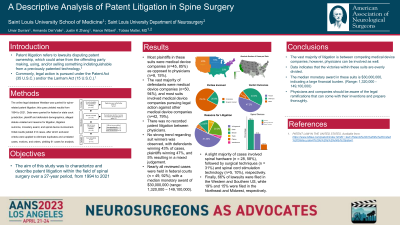A Descriptive Analysis of Patent Litigation in Spine Surgery
Friday, April 21, 2023


Umar S. Durrani, MPH (he/him/his)
Medical Student
Saint Louis University
ePoster Presenter(s)
Introduction: The aim of this study was to characterize and describe patent litigation within the field of spinal surgery over the last 27 years.
Methods: The online legal database Westlaw was queried for spine-related patent litigation, yielding results from 1994 to 2021. Data were queried for federal or state court jurisdiction, plaintiff and defendant demographics, alleged statute violated and reasons for litigation, litigation outcome, monetary award, and spinal device involvement. Initial results yielded 412 cases, after which exclusion criteria were applied to eliminate duplicates and unrelated cases, motions, and orders, leaving 53 cases for analysis.
Results: Results indicated that the plaintiffs were mostly medical device companies (n=45, 85%) as opposed to physicians (n=8, 15%). The vast majority of defendants were medical device companies (n=50, 94%), and most suits involved them pursuing legal action against their counterparts (n=42, 79%). There was no recorded patent litigation between physicians. Defendants won about 43% of cases, while plaintiffs won 47%, and 5% resulted in a mixed judgement. Nearly all reviewed cases were held in federal courts (n = 49, 92%), with a median monetary award of $30,000,000 (range: 1,320,000 – 149,100,000). A slight majority of cases involved spinal hardware (n = 28, 58%), followed by surgical techniques (n = 31%) and spinal cord stimulation technology (n=5, 10%). Finally, 66% of lawsuits were filed in the Western and Southern US, while 19% and 15% were filed in the Northeast and Midwest, respectively.
Conclusion : The vast majority of litigation is between competing medical device companies; though physicians can be involved as well. Victories within these suits are evenly divided; however, what cannot be debated is the financial burden of patent infringement. The median monetary award in these suits is $30,000,000. Physicians and companies should be aware of the legal ramifications that can come with their inventions, and prepare thoroughly.
Methods: The online legal database Westlaw was queried for spine-related patent litigation, yielding results from 1994 to 2021. Data were queried for federal or state court jurisdiction, plaintiff and defendant demographics, alleged statute violated and reasons for litigation, litigation outcome, monetary award, and spinal device involvement. Initial results yielded 412 cases, after which exclusion criteria were applied to eliminate duplicates and unrelated cases, motions, and orders, leaving 53 cases for analysis.
Results: Results indicated that the plaintiffs were mostly medical device companies (n=45, 85%) as opposed to physicians (n=8, 15%). The vast majority of defendants were medical device companies (n=50, 94%), and most suits involved them pursuing legal action against their counterparts (n=42, 79%). There was no recorded patent litigation between physicians. Defendants won about 43% of cases, while plaintiffs won 47%, and 5% resulted in a mixed judgement. Nearly all reviewed cases were held in federal courts (n = 49, 92%), with a median monetary award of $30,000,000 (range: 1,320,000 – 149,100,000). A slight majority of cases involved spinal hardware (n = 28, 58%), followed by surgical techniques (n = 31%) and spinal cord stimulation technology (n=5, 10%). Finally, 66% of lawsuits were filed in the Western and Southern US, while 19% and 15% were filed in the Northeast and Midwest, respectively.
Conclusion : The vast majority of litigation is between competing medical device companies; though physicians can be involved as well. Victories within these suits are evenly divided; however, what cannot be debated is the financial burden of patent infringement. The median monetary award in these suits is $30,000,000. Physicians and companies should be aware of the legal ramifications that can come with their inventions, and prepare thoroughly.
